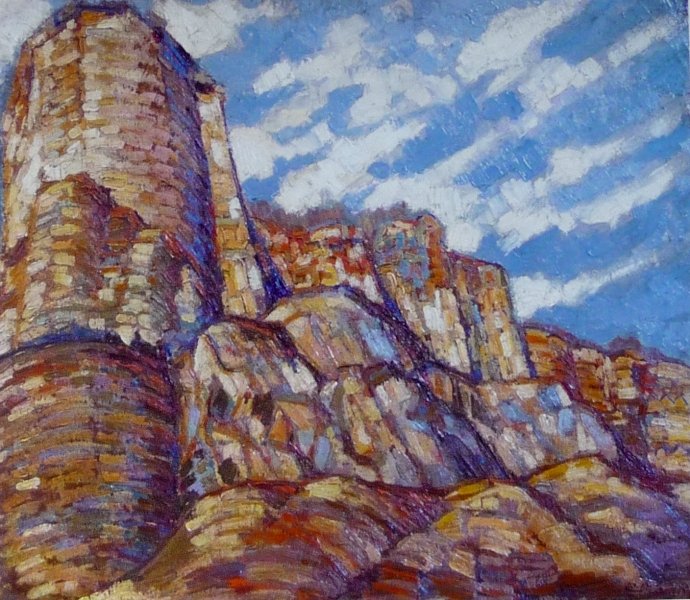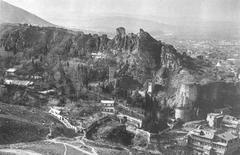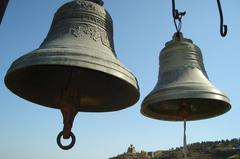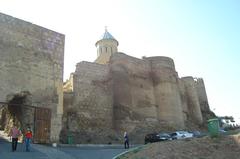
Narikala Fortress Visiting Hours, Tickets, and Comprehensive Guide to Tbilisi’s Historic Landmark
Date: 14/06/2025
Introduction
Narikala Fortress, perched high atop the Sololaki Ridge and overlooking Tbilisi’s Old Town and the Mtkvari River, stands as a testament to Georgia’s rich and turbulent past. Dating back to the 4th century CE, Narikala is both a historical symbol and a living part of Tbilisi’s cultural fabric, offering unmatched panoramic views and a journey through centuries of architectural evolution and multicultural influence. This detailed guide provides everything you need to know for a memorable visit: historical context, visiting hours, ticket information, accessibility, highlights, travel tips, and nearby attractions.
Table of Contents
- Historical Overview
- Layout and Key Features
- Visitor Information
- Highlights, Photography, and Events
- Nearby Attractions
- Frequently Asked Questions (FAQ)
- Practical Tips for Visitors
- Conclusion
- Sources and Official Links
Historical Overview
Origins and Early History
Narikala Fortress dates to the 4th century CE, constructed during the reign of King Varaz-Bakur of the Kingdom of Iberia. Its strategic location atop a steep ridge enabled control over the ancient crossroads between Europe and Asia, safeguarding Tbilisi’s early settlement and vital trade routes. Archaeological and historical records suggest the original fortifications were modest, built mainly of stone and serving as a sentinel over the Silk Road (mexicohistorico.com).
Architectural Evolution
Throughout its history, Narikala has been continuously expanded, destroyed, and rebuilt under the rule of various empires:
- Persian and Arab Periods: The Persians reinforced Narikala in the 5th–6th centuries, adding thicker walls and more complex defensive features. The Arabs, who seized Tbilisi in the 7th century, fortified the fortress further, integrating it into the city’s broader defensive network (kurby.ai; ingeorgiatravel.com).
- Medieval Georgian Rule: Under King David the Builder and Queen Tamar (11th–13th centuries), Narikala expanded significantly, incorporating finely cut stone, new towers, and larger courtyards (kurby.ai).
- Later Modifications: The Mongols, Persians, and Ottomans left their marks, rebuilding after invasions and natural disasters. The 1827 earthquake destroyed much of the original fortress, with subsequent reconstructions dating mainly to the 16th–17th centuries (mexicohistorico.com).
Cultural & Strategic Significance
Narikala has long symbolized Tbilisi’s resilience and multicultural heritage. It served as a defensive stronghold, royal residence, and spiritual center. The fortress’s commanding silhouette is visible from across the city, embodying Tbilisi’s enduring spirit and its role as a crossroads of empires (Ubani Center).
Layout and Key Features
Site Plan and Defensive Structures
Narikala Fortress stretches along the hilltop between the Tbilisi Botanical Garden and the Abanotubani sulfur baths district. The fortress is divided into two main walled sections with surviving towers and curtain walls, some rising up to 12 meters. The irregular plan reflects adaptations to the rugged terrain and piecemeal construction through successive eras (ingeorgiatravel.com; tbilisilocalguide.com).
Many towers are accessible, providing panoramic city views, while others remain in ruins. The fortress’s stone and brickwork exhibit Persian, Arab, and Georgian architectural styles, with walls up to 2 meters thick.
St. Nicholas Church
Within the fortress stands the reconstructed St. Nicholas Church, originally built in the 13th century and rebuilt in the 1990s after destruction in the 1827 earthquake. The church is designed in a traditional Georgian cross-in-square plan, featuring a central dome and modern frescoes depicting biblical and Georgian historical scenes (castlesintheworld.com). Admission is free; respectful attire is required.
Kartlis Deda (Mother of Georgia)
Adjacent to the fortress is the 20-meter-tall Kartlis Deda statue, erected in 1958 for Tbilisi’s 1,500th anniversary. She holds a sword (defense) and a bowl of wine (hospitality), symbolizing the Georgian spirit. The statue is a modern icon and a popular photography subject (tbilisilocalguide.com).
Visitor Information
Visiting Hours and Tickets
- Fortress Grounds: Generally open year-round and accessible at all hours. However, due to renovations, the site may be temporarily closed—check current status before planning your visit (wander-lush.org).
- St. Nicholas Church: Open for visits during the day; hours may be limited during services.
- Admission: Entry to the fortress grounds and St. Nicholas Church is free.
- Cable Car: The cable car from Rike Park to Narikala operates daily, ticket cost ~2.5–5 GEL one-way (travejar.com).
How to Get There
- Cable Car: Offers a scenic and accessible ride from Rike Park to the fortress.
- On Foot: A moderately challenging 15–25 minute climb from the Abanotubani sulfur baths via marked paths and stairs.
- Taxi: Taxis can drop visitors near Old Town; the final ascent is on foot (georgiaintrend.com).
Accessibility
The fortress’s steep, uneven terrain and lack of railings can be difficult for visitors with mobility challenges. The cable car eases the ascent, but sturdy shoes are necessary. Assistance may be required for wheelchair users.
Dress Code and Etiquette
- St. Nicholas Church: Modest dress is required—women should wear headscarves, men should avoid shorts/hats inside.
- General Conduct: Respect the historic and religious nature of the site; avoid loud noise and climbing on fragile ruins.
Highlights, Photography, and Events
- Panoramic Views: The fortress offers some of the best vistas of Old Town, the Mtkvari River, Peace Bridge, and the city skyline. Sunset and evening visits are especially beautiful (viacation.com).
- Historic Walls and Towers: Weathered stonework and towers make for dramatic photos.
- Kartlis Deda Statue: Striking in the golden hour or after dark.
- Special Events: Narikala occasionally hosts festivals, artisan markets, and music performances, especially during citywide celebrations (cultureactivities.com).
Photography is permitted throughout the fortress; flash/tripods may be restricted inside the church.
Nearby Attractions
- Tbilisi Botanical Garden: Adjacent to Narikala, with nature trails and waterfalls.
- Abanotubani Sulfur Baths: Historic bathhouses just below the fortress.
- Kala District and Old Town: Winding streets, cafes, markets, and artisan shops.
Frequently Asked Questions (FAQ)
Q: What are Narikala Fortress visiting hours?
A: The grounds are generally open all day, but check for temporary closures due to renovations.
Q: Is there an entrance fee?
A: No, entry to the fortress and St. Nicholas Church is free. The cable car requires a ticket.
Q: How can I get to Narikala Fortress?
A: By foot (from Old Town), cable car (from Rike Park), or taxi to the base.
Q: Is the site accessible for people with disabilities?
A: Terrain is steep and uneven; cable car assists with ascent, but full accessibility is limited.
Q: Are guided tours available?
A: Yes, local guides offer tours as part of broader Tbilisi historical excursions (georgiaintrend.com).
Practical Tips for Visitors
- Wear sturdy footwear for uneven paths.
- Bring water and sun protection, especially in warm months.
- Visit early morning or late afternoon to avoid crowds and heat.
- Dress respectfully in the church.
- Supervise children near open walls and drops.
- Check status of renovations or closures before visiting.
Conclusion
Narikala Fortress is an essential destination for understanding Tbilisi’s history, culture, and landscape. Free to enter and rich in architectural and scenic beauty, it offers something for every traveler. Combine your visit with nearby attractions like the sulfur baths and Botanical Garden for a fuller Tbilisi experience. For real-time updates, event listings, and in-depth guides, download the Audiala app and follow official tourism resources.
Sources and Official Links
- The Cultural Significance of Old Tbilisi in Georgia – mexicohistorico.com
- From Past to Present: The Evolution of Tbilisi, Georgia’s Architecture – kurby.ai
- Narikala Fortress Blog – ingeorgiatravel.com
- Narikala Fortress: A Symbol of Old City – Ubani Center
- Best Things to Do in Tbilisi – Lasma Plone
- Capital of Georgia: The Country – Travel Pander
- Narikala Fortress Visitor Guide – georgiaintrend.com
- Narikala Fortress Tbilisi Georgia – Wander-Lush.org
- Castles in the World – Narikala Fortress
- Tbilisi Local Guide – Narikala Fortress
- Travejar – Narikala Fortress
- Nomad Epic – Best Places in Tbilisi
- Viacation – Narikala Fortress
- Culture Activities – Tbilisi


































